Formulation Development, Statistical Optimization, In Vitro and In Vivo Evaluation of Etoricoxib-Loaded Eucalyptus Oil-Based Nanoemulgel for Topical Delivery
Abstract
:1. Introduction
2. Materials and Methods
2.1. Materials
2.2. Solubility of ETB in Formulation Components
2.3. Formulation and Optimization of Etoricoxib-Loaded NE (ETB-NE)
2.4. Thermodynamic Stability and Dispersibility Studies of the Optimized ETB-NE
2.5. Characterization of Optimized ETB-NE
2.5.1. Particle Size Analysis and Zeta Potential Determination
2.5.2. Transmission Electron Microscopy
2.5.3. Refractive Index and Percentage Transmittance of ETB-NE
2.6. Preparation of ETB-NEG Using Optimized ETB-NE
2.7. In Vitro Drug Release Studies
2.8. pH, Viscosity, Drug Content, and Percentage Entrapment Efficiency of ETB-NEG
2.9. In Vitro Skin Permeation Studies with ETB-NEG
2.10. In Vivo Studies with ETB-NEG
2.10.1. Analgesic Activity
Hot Plate Method
Formalin-Induced Paw Licking Test
2.10.2. Anti-Inflammatory Activity
2.10.3. Histopathology of Treated Rat Skin
2.11. Statistical Analysis
3. Results and Discussion
3.1. Solubility of ETB in Formulation Components
3.2. Formulation and Optimization of Etoricoxib-Loaded NE (ETB-NE)
3.3. Thermodynamic Stability and Dispersibility Studies of the Optimized ETB-NE
3.4. Characterization of Optimized ETB-NE
3.4.1. Particle Size Analysis and Zeta Potential Determination
3.4.2. Transmission Electron Microscopy
3.4.3. Refractive Index and Percentage Transmittance of ETB-NE
3.5. In Vitro Drug Release from ETB-NE
3.6. pH, Viscosity, Drug Content, and Percentage Entrapment Efficiency of ETB-NEG
3.7. In Vitro Skin Permeation Studies with ETB-NEG
3.8. In Vivo Studies with ETB-NEG
3.8.1. Analgesic Activity
Hot Plate Method
Formalin-Induced Paw Licking Test
3.8.2. Anti-Inflammatory Activity
3.8.3. Histopathology Studies
4. Conclusions
Author Contributions
Funding
Institutional Review Board Statement
Informed Consent Statement
Data Availability Statement
Acknowledgments
Conflicts of Interest
References
- Kwiatkowska, B.; Majdan, M.; Mastalerz-Migas, A.; Niewada, M.; Skrzydło-Radomańska, B.; Mamcarz, A. Status of etoricoxib in the treatment of rheumatic diseases. Expert panel opinion. Reumatologia 2017, 55, 290–297. Available online: https://pubmed.ncbi.nlm.nih.gov/29491537 (accessed on 10 February 2019). [CrossRef]
- Ho, K.Y.; Gwee, K.A.; Cheng, Y.K.; Yoon, K.H.; Hee, H.T.; Omar, A.R. Nonsteroidal anti-inflammatory drugs in chronic pain: Implications of new data for clinical practice. J. Pain Res. 2018, 11, 1937–1948. Available online: https://pubmed.ncbi.nlm.nih.gov/30288088 (accessed on 10 February 2019). [CrossRef] [PubMed] [Green Version]
- Zhang, S.; Zhang, Y.; Liu, P.; Zhang, W.; Ma, J.-L.; Wang, J. Efficacy and safety of etoricoxib compared with NSAIDs in acute gout: A systematic review and a meta-analysis. Clin. Rheumatol. 2015, 35, 151–158. [Google Scholar] [CrossRef]
- Birmingham, B.; Buvanendran, A. 40—Nonsteroidal anti-inflammatory drugs, acetaminophen, and COX-2 inhibitors. In Practical Management of Pain, 5th ed.; Benzon, H.T., Rathmell, J.P., Hurley, W., Eds.; Mosby: Maryland Heights, MI, USA, 2014; pp. 553–568.e5. Available online: https://www.sciencedirect.com/science/article/pii/B9780323083409000402 (accessed on 12 February 2019).
- Williams, B.S.; Buvanendran, A. Nonopioid analgesics: NSAIDs, COX-2 inhibitors, and acetaminophen. In Essentials of Pain Medicine, 3rd ed.; Benzon, H.T., Raja, S.N., Liu, S.S., Fishman, S.M., Cohen, S.P., Hurley, R.W., Natouze, S., Malik, K.M., Candido, K.D., Eds.; Elsevier: Amsterdam, The Netherlands, 2011; Chapter 17; pp. 641–668. Available online: https://www.sciencedirect.com/science/article/pii/B9781437722420000262 (accessed on 18 February 2019).
- Capone, M.L.; Tacconelli, S.; Patrignani, P. Clinical pharmacology of etoricoxib. Expert. Opin. Drug Metab. Toxicol. 2005, 1, 269–282. [Google Scholar] [CrossRef]
- Croom, K.F.; Siddiqui, M.A.A. Etoricoxib. Drugs 2009, 69, 1513–1532. [Google Scholar] [CrossRef]
- Dhande, P.P.; Gupta, A.O.; Jain, S.; Dawane, J.S. Anti-inflammatory and Analgesic Activities of Topical Formulations of Pterocarpus Santalinus Powder in Rat Model of Chronic Inflammation. J. Clin. Diagn. Res. 2017, 11, FF01–FF04. Available online: https://pubmed.ncbi.nlm.nih.gov/28892928 (accessed on 25 April 2019). [CrossRef]
- Pramod, K.; Shanavas, S.; Ansari, S.H.; Ali, J. Eugenol Nanodroplet Gel as Novel Biomaterial in Nanomedicine. Adv. Sci. Lett. 2012, 10, 1–13. [Google Scholar] [CrossRef]
- Nastiti, C.M.R.R.; Ponto, T.; Abd, E.; Grice, J.E.; Benson, H.A.E.; Roberts, M.S. Topical Nano and Microemulsions for Skin Delivery. Pharmaceutics 2017, 9, 37. Available online: https://pubmed.ncbi.nlm.nih.gov/28934172 (accessed on 22 March 2019). [CrossRef] [PubMed]
- Fox, L.T.; Gerber, M.; Du Plessis, J.; Hamman, J.H. Transdermal Drug Delivery Enhancement by Compounds of Natural Origin. Molecules 2011, 16, 10507–10540. Available online: https://www.ncbi.nlm.nih.gov/pmc/articles/PMC6264261/ (accessed on 11 February 2019). [CrossRef]
- Silva, J.; Abebe, W.; Sousa, S.; Duarte, V.; Machado, M.; Matos, F. Analgesic and anti-inflammatory effects of essential oils of Eucalyptus. J. Ethnopharmacol. 2003, 89, 277–283. [Google Scholar] [CrossRef] [PubMed]
- Sebei, K.; Sakouhi, F.; Herchi, W.; Khouja, M.L.; Boukhchina, S. Chemical composition and antibacterial activities of seven Euca-lyptus species essential oils leaves. Biol. Res. 2015, 48, 7. Available online: https://pubmed.ncbi.nlm.nih.gov/25654423 (accessed on 15 February 2019). [CrossRef] [Green Version]
- Vasudevan, D.T.; Rajan, R. Effect of permeation enhancers on the penetration mechanism of transfersomal gel of ketoconazole. J. Adv. Pharm. Technol. Res. 2012, 3, 112–116. Available online: https://pubmed.ncbi.nlm.nih.gov/22837959 (accessed on 18 February 2019). [CrossRef] [PubMed]
- Lee, C.H.; Moturi, V.; Lee, Y. Thixotropic property in pharmaceutical formulations. J. Control. Release 2009, 136, 88–98. Available online: https://www.sciencedirect.com/science/article/pii/S0168365909001254 (accessed on 19 April 2019). [CrossRef]
- Zheng, Y.; Ouyang, W.-Q.; Wei, Y.-P.; Syed, S.F.; Hao, C.-S.; Wang, B.-Z.; Shang, Y.-H. Effects of Carbopol® 934 proportion on nanoemulsion gel for topical and transdermal drug delivery: A skin permeation study. Int. J. Nanomed. 2016, 11, 5971–5987. [Google Scholar] [CrossRef] [PubMed] [Green Version]
- Lala, R.R.; Awari, N.G. Nanoemulsion-based gel formulations of COX-2 inhibitors for enhanced efficacy in inflammatory conditions. Appl. Nanosci. 2014, 4, 143–151. [Google Scholar] [CrossRef] [Green Version]
- Kotta, S.; Khan, A.W.; Ansari, S.H.; Sharma, R.K.; Ali, J. Formulation of nanoemulsion: A comparison between phase inversion composition method and high-pressure homogenization method. Drug Deliv. 2015, 22, 455–466. [Google Scholar] [CrossRef]
- Abdelmonem, R.; Younis, M.K.; Hassan, D.H.; El-Sayed Ahmed, M.A.E.-G.; Hassanein, E.; El-Batouty, K.; Elfaham, A. Formulation and characterization of chlorhexidine HCl nanoemulsion as a promising antibacterial root canal irrigant: In-vitro and ex-vivo studies. Int. J. Nanomed. 2019, 14, 4697–4708. Available online: https://pubmed.ncbi.nlm.nih.gov/31303754 (accessed on 24 March 2020). [CrossRef] [Green Version]
- Kotta, S.; Mubarak Aldawsari, H.; Badr-Eldin, S.M.; Alhakamy, N.A.; Shadab. Coconut oil-based resveratrol nanoemulsion: Opti-mization using response surface methodology, stability assessment and pharmacokinetic evaluation. Food Chem. 2021, 357, 129721. Available online: https://www.sciencedirect.com/science/article/pii/S0308814621007275 (accessed on 7 May 2021). [CrossRef] [PubMed]
- Sarheed, O.; Shouqair, D.; Ramesh, K.V.R.N.S.; Khaleel, T.; Amin, M.; Boateng, J.; Drechsler, M. Formation of stable nanoemulsions by ultra-sound-assisted two-step emulsification process for topical drug delivery: Effect of oil phase composition and surfactant concentration and loratadine as ripening inhibitor. Int. J. Pharm. 2020, 576, 118952. Available online: https://www.sciencedirect.com/science/article/pii/S0378517319309974 (accessed on 15 May 2021). [CrossRef]
- Arora, R.; Aggarwal, G.; Harikumar, S.L.; Kaur, K. Nanoemulsion Based Hydrogel for Enhanced Transdermal Delivery of Ketoprofen. Adv. Pharm. 2014, 2014, 1–12. [Google Scholar] [CrossRef]
- Fan, S.-H.; Ali, N.A.; Basri, D.F. Evaluation of Analgesic Activity of the Methanol Extract from the Galls of Quercus infectoria(Olivier) in Rats. Evidence-Based Complement. Altern. Med. 2014, 2014, 1–6. [Google Scholar] [CrossRef] [Green Version]
- Desai, S.; Ahmad, A.; Gite, M.; Gavitre, B.; More, Y.; Kundnani, K. Comparative evaluation of polyherbal formulations for an-ti-inflammatory and analgesic activity in rats and mice. Der Pharm Lett. 2010, 2, 285–290. [Google Scholar]
- Singh, M.; Kumar, V.; Singh, I.; Gauttam, V.; Kalia, A.N. Anti-inflammatory activity of aqueous extract of Mirabilis jalapa Linn. leaves. Pharmacogn. Res. 2010, 2, 364–367. Available online: https://pubmed.ncbi.nlm.nih.gov/21713140 (accessed on 13 June 2019). [CrossRef] [Green Version]
- Hussain, A.; Samad, A.; Singh, S.K.; Ahsan, M.N.; Haque, M.W.; Faruk, A.; Ahmed, F.J. Nanoemulsion gel-based topical delivery of an antifungal drug in vitro activity and in vivo evaluation. Drug Deliv. 2014, 23, 642–657. [Google Scholar] [CrossRef] [PubMed]
- Acharya, A.K.; Majumdar, D.K.; Mishra, G.; Mohanty, B. In vitro corneal permeation of etoricoxib from oil drops. Asian J. Pharm. 2018, 12, S1208–S1214. Available online: https://www.asiapharmaceutics.info/index.php/ajp/article/view/2912 (accessed on 4 March 2019).
- Kaur, N.; Kocher, D.; Sidhu, A. Synthesis and Testing of Eucalyptus globulus Oil-Based Nanoemulsion for Its Larvicidal Potential against Aedes aegypti. Afr. Èntomol. 2019, 27, 433–438. [Google Scholar] [CrossRef]
- Nayak, A.K.; Panigrahi, P.P. Solubility Enhancement of Etoricoxib by Cosolvency Approach. ISRN Phys. Chem. 2012, 2012, 1–5. [Google Scholar] [CrossRef] [Green Version]
- Bolourchian, N.; Mahboobian, M.M.; Dadashzadeh, S. The Effect of PEG Molecular Weights on Dissolution Behavior of Simvastatin in Solid Dispersions. Iran. J. Pharm. Res. IJPR 2013, 12, 9–18. Available online: https://pubmed.ncbi.nlm.nih.gov/24250667 (accessed on 4 May 2020).
- Fonseca, V.R.; Bhide, P.J.; Joshi, M.P. Formulation, Development and Evaluation of Etoricoxib Nanosize Microemulsion Based Gel for Topical Drug Delivery. Indian J. Pharm. Educ. Res. 2019, 53, s571–s579. [Google Scholar] [CrossRef] [Green Version]
- Laxmi, M.; Bhardwaj, A.; Mehta, S.; Mehta, A. Development and characterization of nanoemulsion as carrier for the enhancement of bioavailability of artemether. Artif. Cells Nanomed. Biotechnol. 2013, 43, 334–344. [Google Scholar] [CrossRef]
- Aboofazeli, R. Nanometric-Scaled Emulsions (Nanoemulsions). Iran. J. Pharm. Res. IJPR 2010, 9, 325–326. Available online: https://pubmed.ncbi.nlm.nih.gov/24381596 (accessed on 17 March 2020).
- Adak, T.; Barik, N.; Patil, N.B.; Govindharaj, G.-P.-P.; Gadratagi, B.G.; Annamalai, M.; Mukherjee, A.K.; Rath, P.C. Nanoemulsion of eucalyptus oil: An al-ternative to synthetic pesticides against two major storage insects (Sitophilus oryzae (L.) and Tribolium castaneum (Herbst)) of rice. Ind. Crops Prod. 2020, 143, 111849. Available online: https://www.sciencedirect.com/science/article/pii/S0926669019308593 (accessed on 6 May 2021). [CrossRef]
- De Godoi, S.N.; Quatrin, P.M.; Sagrillo, M.R.; Nascimento, K.; Wagner, R.; Klein, B.; Santos, R.C.V.; Ourique, A.F. Evaluation of stability and in vitro security of nanoemulsions containing eucalyptus globulus oil. BioMed Res. Int. 2017, 2017, 1–10. [Google Scholar] [CrossRef] [Green Version]
- Zhang, Y.; Xin, C.; Cheng, C.; Wang, Z. Antitumor activity of nanoemulsion based on essential oil of Pinus koraiensis pinecones in MGC-803 tumor-bearing nude mice. Arab. J. Chem. 2020, 13, 8226–8238. Available online: https://www.sciencedirect.com/science/article/pii/S1878535220303920 (accessed on 4 May 2021). [CrossRef]
- Waxler, R.M.; Weir, C.E. Effect of pressure and temperature on the refractive indices of benzene, carbon tetrachloride, and water. J. Res. Natl. Bur. Stand. Sect. A: Phys. Chem. 1963, 67, 163–171. Available online: https://pubmed.ncbi.nlm.nih.gov/31580621 (accessed on 4 March 2021). [CrossRef] [PubMed]
- AlGahtani, M.S.; Ahmad, M.Z.; Ahmad, J. Nanoemulgel for improved topical delivery of retinyl palmitate: Formulation design and stability evaluation. Nanomaterials 2020, 10, 848. [Google Scholar] [CrossRef]
- Thomas, L.; Zakir, F.; Mirza, M.A.; Anwer, K.; Ahmad, F.; Iqbal, Z. Development of Curcumin loaded chitosan polymer based nanoemulsion gel: In vitro, ex vivo evaluation and in vivo wound healing studies. Int. J. Biol. Macromol. 2017, 101, 569–579. Available online: https://www.sciencedirect.com/science/article/pii/S0141813016328495 (accessed on 4 March 2021). [CrossRef]
- Shakeel, F.; Ramadan, W.; Ahmed, M.A. Investigation of true nanoemulsions for transdermal potential of indomethacin: Characterization, rheological characteristics, and ex vivo skin permeation studies. J. Drug Target. 2009, 17, 435–441. [Google Scholar] [CrossRef] [PubMed]
- Neupane, R.; Boddu, S.H.; Renukuntla, J.; Babu, R.J.; Tiwari, A.K. Alternatives to Biological Skin in Permeation Studies: Current Trends and Possibilities. Pharmaceutics 2020, 12, 152. [Google Scholar] [CrossRef] [PubMed] [Green Version]
- Aziz, Z.A.A.; Nasir, H.M.; Ahmad, A.; Setapar, S.H.M.; Ahmad, H.; Noor, M.H.M.; Rafatullah, M.; Khatoon, A.; Kausar, M.A.; Ahmad, I.; et al. Enrichment of Eucalyptus oil nanoemulsion by micellar nanotechnology: Transdermal analgesic activity using hot plate test in rats’ assay. Sci. Rep. 2019, 9, 1–16. [Google Scholar] [CrossRef]
- Bhutia, Y.D.; Vijayaraghavan, R.; Pathak, U. Analgesic and anti-inflammatory activity of amifostine, DRDE-07, and their analogs, in mice. Indian J. Pharmacol. 2010, 42, 17–20. Available online: https://pubmed.ncbi.nlm.nih.gov/20606831 (accessed on 5 April 2021). [CrossRef] [PubMed]
- Shadab; Alhakamy, N.; Aldawsari, H.M.; Kotta, S.; Ahmad, J.; Akhter, S.; Alam, S.; Khan, M.A.; Awan, Z.; Sivakumar, P.M. Improved Analgesic and Anti-Inflammatory Effect of Diclofenac Sodium by Topical Nanoemulgel: Formulation Development—In Vitro and In Vivo Studies. J. Chem. 2020, 2020, 4071818. [Google Scholar] [CrossRef] [Green Version]
- Baboota, S.; Shakeel, F.; Ahuja, A.; Ali, J.; Shafiq, S. Design, development and evaluation of novel nanoemulsion formulations for transdermal potential of celecoxib. Acta Pharm. 2007, 57, 315–332. Available online: https://content.sciendo.com/view/journals/acph/57/3/article-p315.xml (accessed on 3 February 2019). [CrossRef] [PubMed] [Green Version]
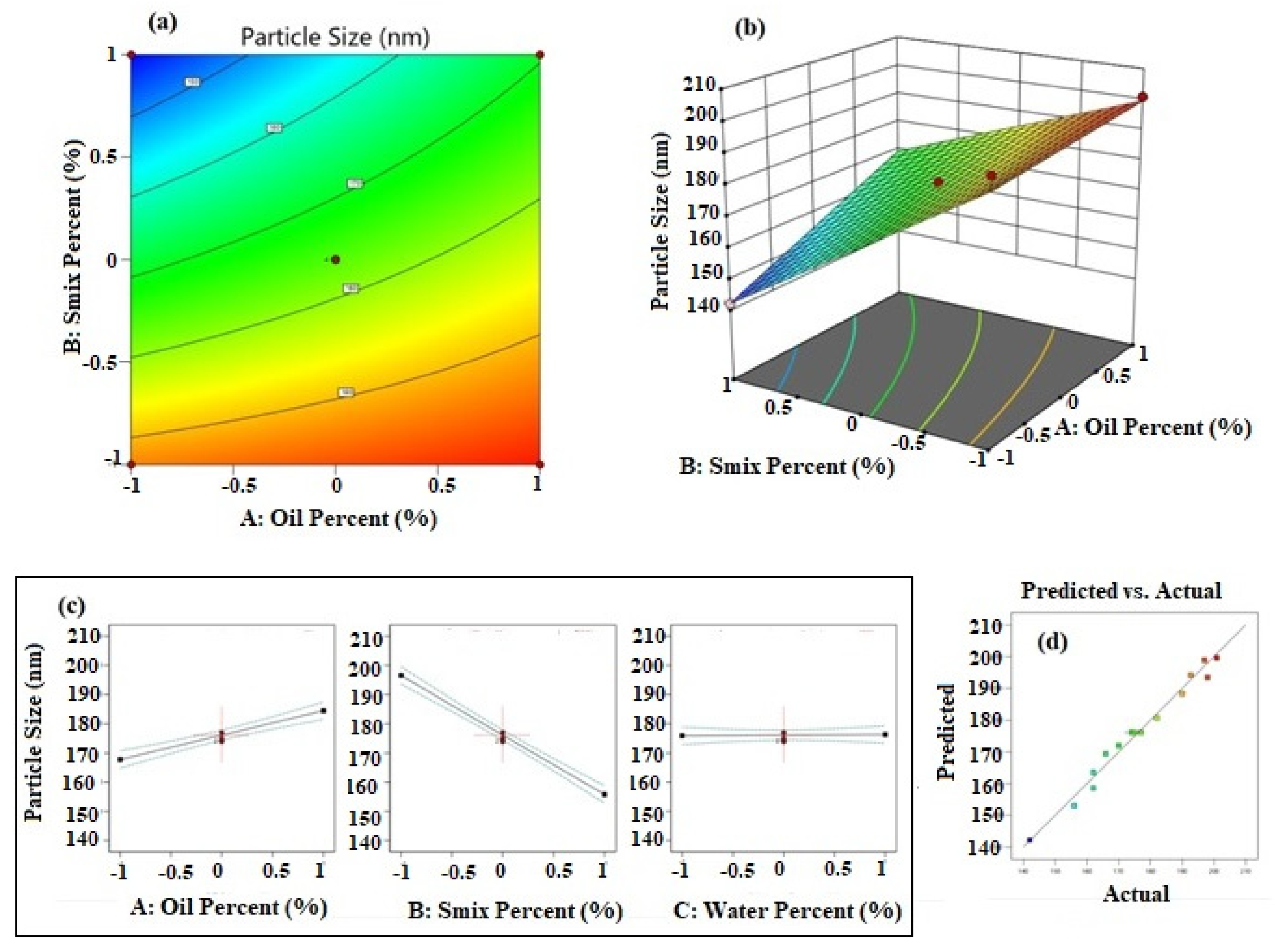
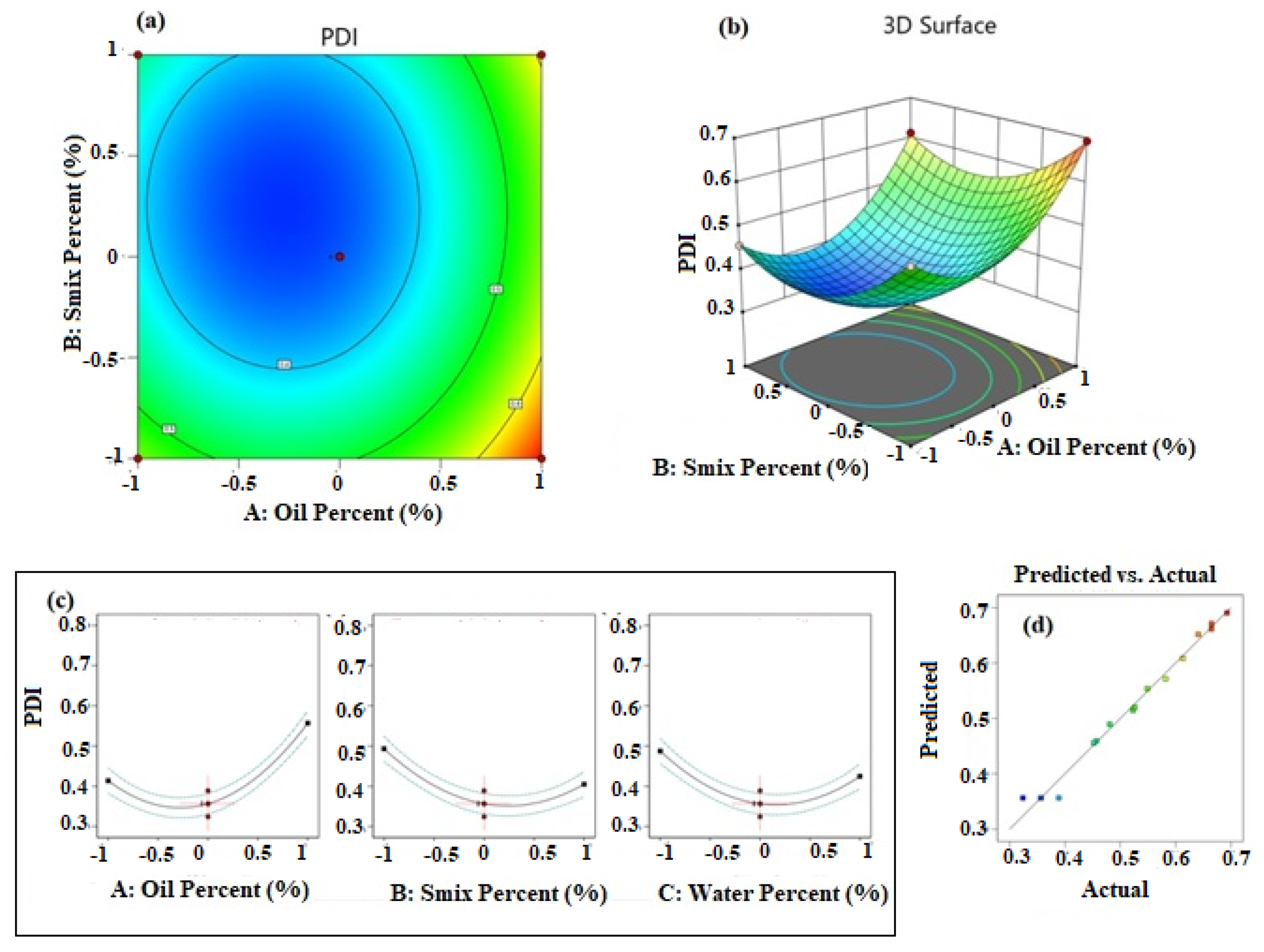
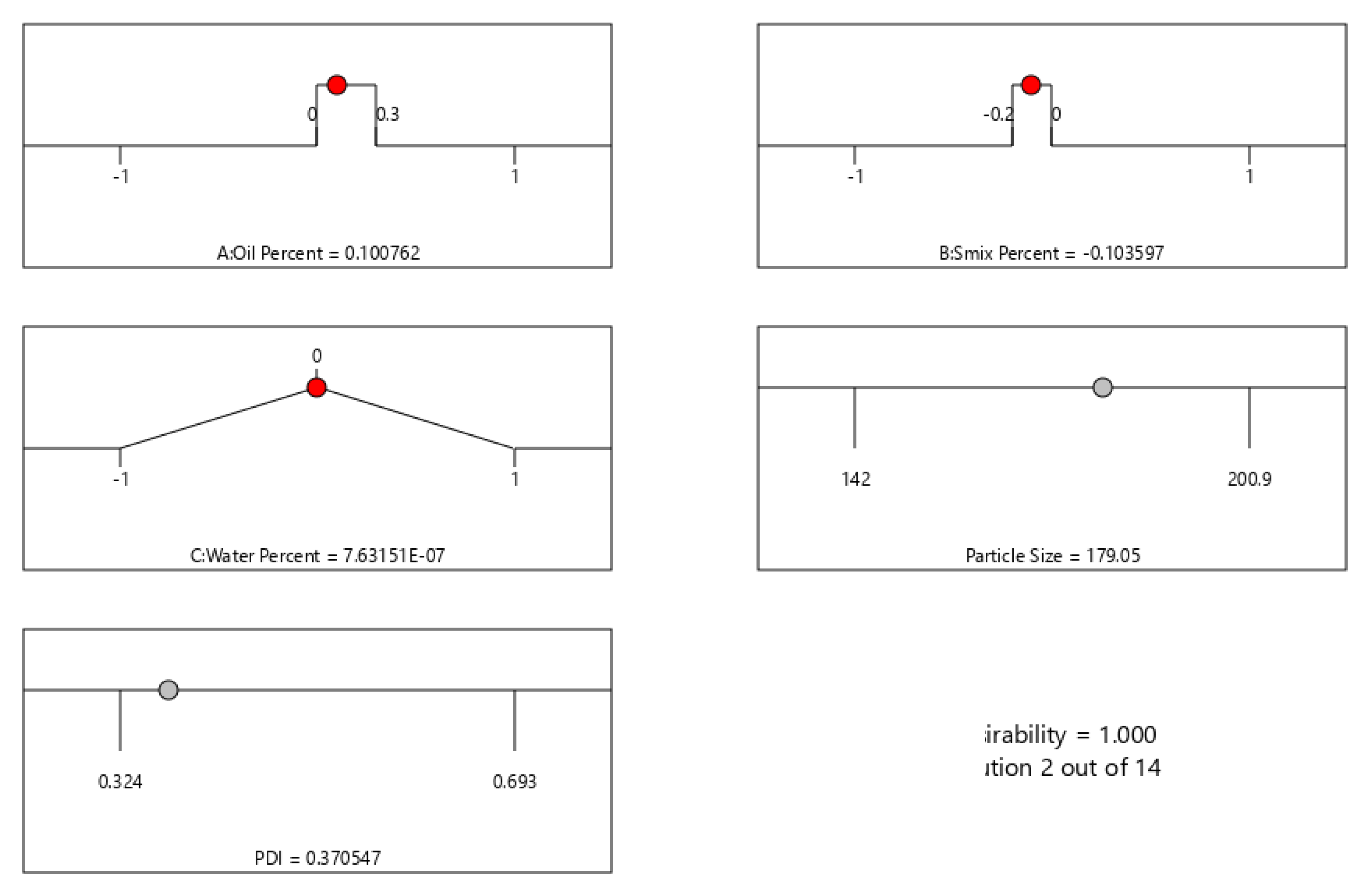
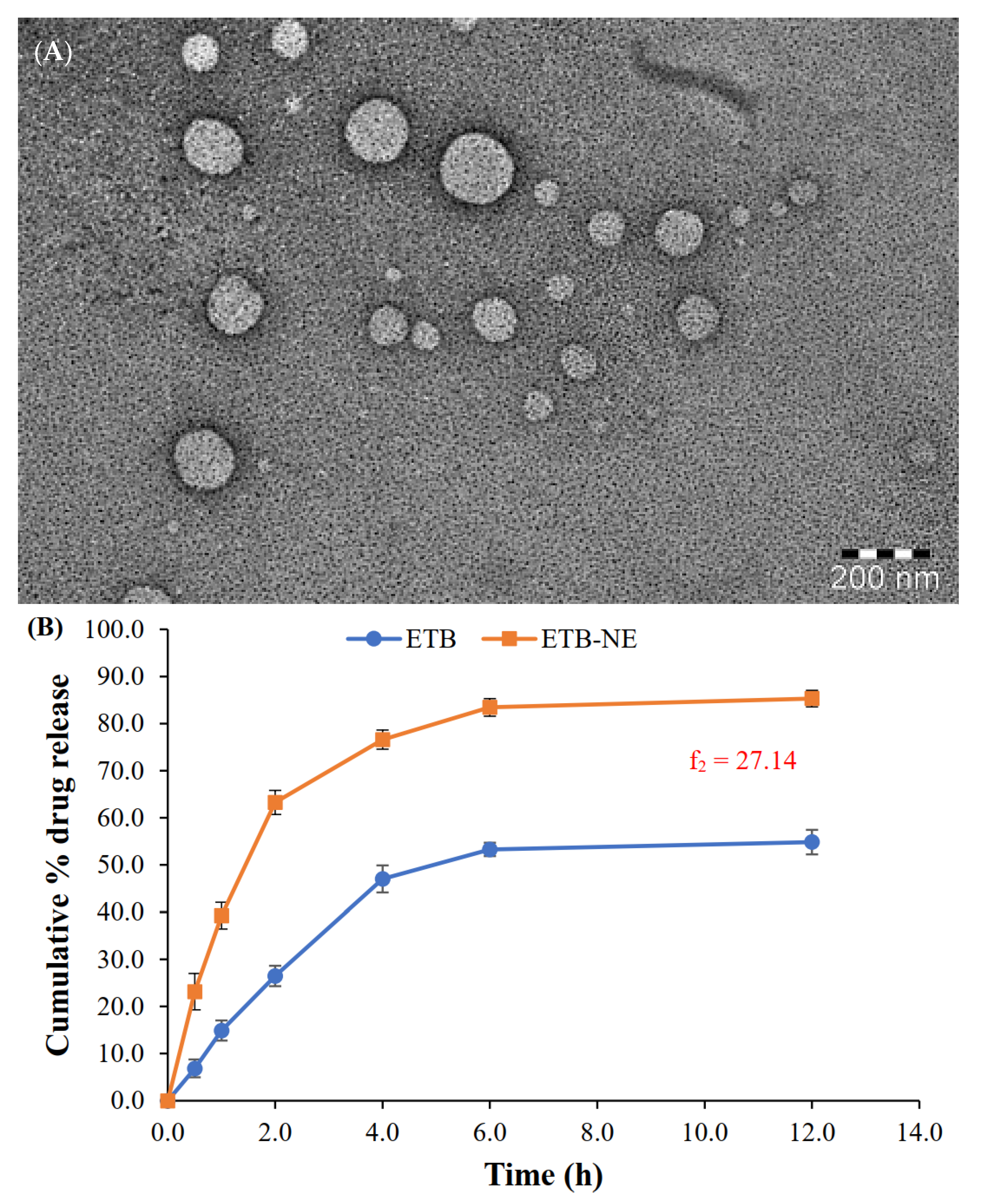

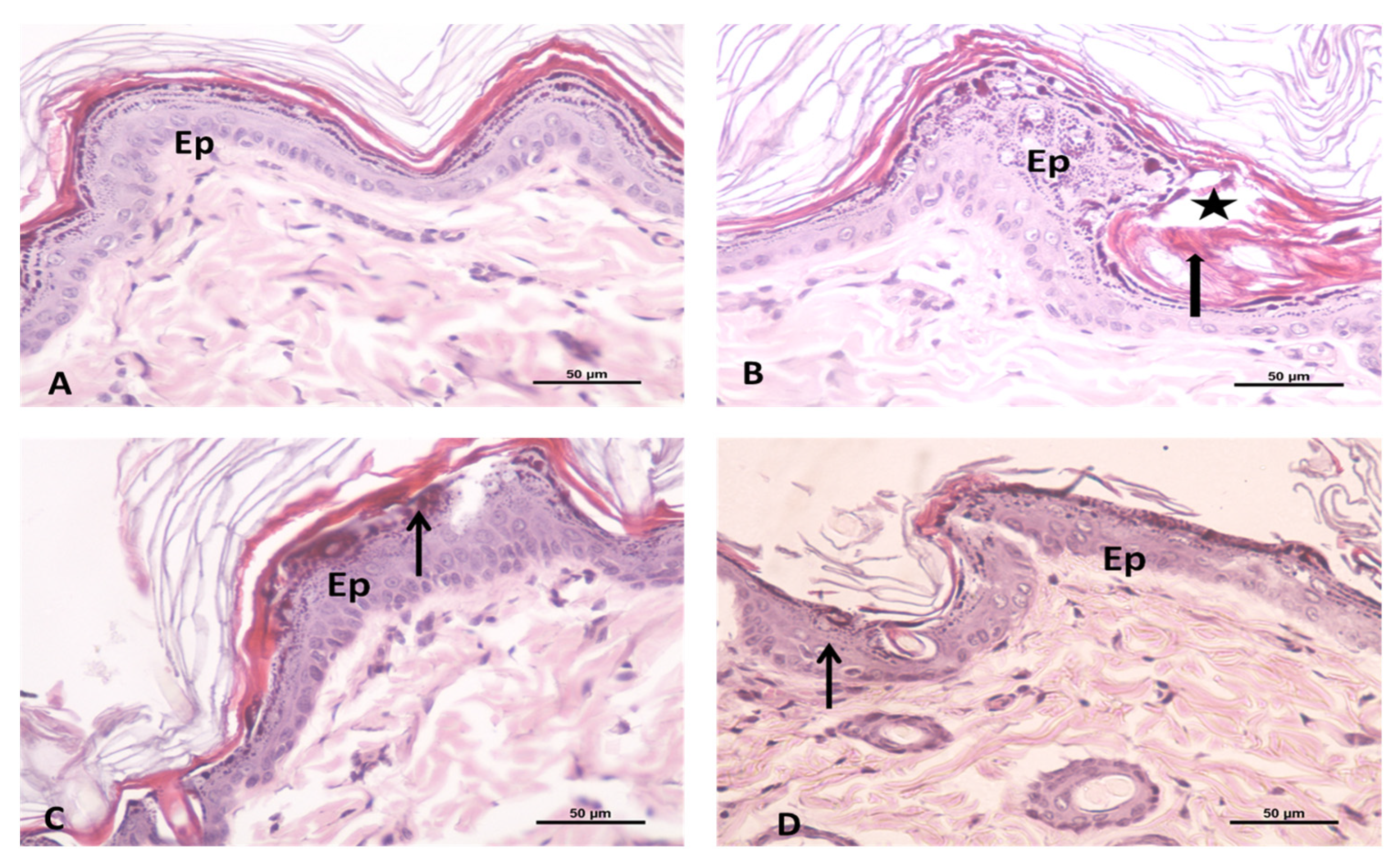
| Run | Factor Codes | Factor Values | ||||
|---|---|---|---|---|---|---|
| Factor A: Oil (Levels) | Factor B: Smix (Levels) | Factor C: Water (Levels) | Factor A: Oil (%) | Factor B: Smix (%) | Factor C: Water (%) | |
| 1 | 1 | 0 | −1 | 20 | 40 | 30 |
| 2 | −1 | 0 | −1 | 5 | 40 | 30 |
| 3 | −1 | 1 | 0 | 5 | 55 | 50 |
| 4 | 0 | 1 | −1 | 10 | 55 | 30 |
| 5 | 0 | 0 | 0 | 10 | 40 | 50 |
| 6 | 0 | 0 | 0 | 10 | 40 | 50 |
| 7 | 1 | 0 | 1 | 20 | 40 | 70 |
| 8 | 1 | 1 | 0 | 20 | 55 | 50 |
| 9 | 0 | −1 | 1 | 10 | 25 | 70 |
| 10 | 0 | 0 | 0 | 10 | 40 | 50 |
| 11 | 1 | −1 | 0 | 20 | 25 | 50 |
| 12 | 0 | 0 | 0 | 10 | 40 | 50 |
| 13 | −1 | 0 | 1 | 5 | 40 | 70 |
| 14 | 0 | 1 | 1 | 10 | 55 | 70 |
| 15 | −1 | −1 | 0 | 5 | 25 | 50 |
| 16 | 0 | −1 | −1 | 10 | 25 | 30 |
| Method | Evaluation | |
|---|---|---|
| Centrifugation | 5000 rpm; 30 min | Cracking, Creaming, and Phase separation |
| Heating-cooling cycle | 4 °C and 40 °C; 48 h in each temperature; 3 cycles | |
| Freeze-thaw cycle | −20 °C and 25 °C; 48 h in each temperature; 3 cycles | |
| Dispersibility | 500 mL of water at 37 ± 0.5 °C; rotating paddle apparatus; 50 rpm | Clarity |
| Run | Independent Factors | Dependent Factors | |||||
|---|---|---|---|---|---|---|---|
| Factor A: Oil (%) | Factor B: Smix (%) | Factor C: Water (%) | Response 1: Mean Particle Size (PS) (nm) | Response 2: PDI | |||
| Observed | Predicted | Observed | Predicted | ||||
| 1 | 20 | 40 | 30 | 190 | 188.29 | 0.665 | 0.6614 |
| 2 | 5 | 40 | 30 | 162 | 163.59 | 0.582 | 0.5714 |
| 3 | 5 | 55 | 50 | 142 | 142.22 | 0.457 | 0.4594 |
| 4 | 10 | 55 | 30 | 156 | 153.03 | 0.481 | 0.4892 |
| 5 | 10 | 40 | 50 | 175 | 176.16 | 0.324 | 0.3565 |
| 6 | 10 | 40 | 50 | 177 | 176.16 | 0.389 | 0.3565 |
| 7 | 20 | 40 | 70 | 182 | 180.72 | 0.641 | 0.6516 |
| 8 | 20 | 55 | 50 | 165.9 | 169.42 | 0.613 | 0.6084 |
| 9 | 10 | 25 | 70 | 192.7 | 194.13 | 0.523 | 0.5147 |
| 10 | 10 | 40 | 50 | 174 | 176.16 | 0.356 | 0.3565 |
| 11 | 20 | 25 | 50 | 200.9 | 199.59 | 0.693 | 0.6906 |
| 12 | 10 | 40 | 50 | 174 | 176.16 | 0.357 | 0.3565 |
| 13 | 5 | 40 | 70 | 170 | 172.02 | 0.452 | 0.4556 |
| 14 | 10 | 55 | 70 | 162 | 158.61 | 0.526 | 0.5200 |
| 15 | 5 | 25 | 50 | 198 | 193.39 | 0.549 | 0.5536 |
| 16 | 10 | 25 | 30 | 197 | 198.86 | 0.665 | 0.6710 |
| Source | Sum of Squares | df | Mean Square | F-Value | p-Value | |
|---|---|---|---|---|---|---|
| Model | 4067.82 | 6 | 677.97 | 72.90 | <0.0001 | significant |
| A—Oil Percentage | 557.78 | 1 | 557.78 | 59.98 | <0.0001 | - |
| B—Smix Percentage | 3308.91 | 1 | 3308.91 | 355.82 | <0.0001 | - |
| C—Water Percentage | 0.3613 | 1 | 0.3613 | 0.0388 | 0.8481 | - |
| AB | 110.25 | 1 | 110.25 | 11.86 | 0.0074 | - |
| AC | 64.00 | 1 | 64.00 | 6.88 | 0.0277 | - |
| BC | 26.52 | 1 | 26.52 | 2.85 | 0.1255 | - |
| Residual | 83.69 | 9 | 9.30 | - | - | - |
| Lack of Fit | 77.69 | 6 | 12.95 | 6.47 | 0.0769 | not significant |
| Pure Error | 6.00 | 3 | 2.00 | - | - | - |
| Cor Total | 4151.52 | 15 | - | - | - | - |
| Source | Sum of Squares | df | Mean Square | F-Value | p-Value | |
|---|---|---|---|---|---|---|
| Model | 0.2164 | 9 | 0.0240 | 54.91 | <0.0001 | significant |
| A—Oil Percentage | 0.0409 | 1 | 0.0409 | 93.40 | <0.0001 | - |
| B—Smix Percentage | 0.0156 | 1 | 0.0156 | 35.57 | 0.0010 | - |
| C—Water Percentage | 0.0079 | 1 | 0.0079 | 17.98 | 0.0054 | - |
| AB | 0.0000 | 1 | 0.0000 | 0.0822 | 0.7840 | - |
| AC | 0.0028 | 1 | 0.0028 | 6.42 | 0.0445 | - |
| BC | 0.0087 | 1 | 0.0087 | 19.97 | 0.0042 | - |
| A2 | 0.0664 | 1 | 0.0664 | 151.72 | <0.0001 | - |
| B2 | 0.0343 | 1 | 0.0343 | 78.37 | 0.0001 | - |
| C2 | 0.0397 | 1 | 0.0397 | 90.67 | <0.0001 | - |
| Residual | 0.0026 | 6 | 0.0004 | - | - | - |
| Lack of Fit | 0.0005 | 3 | 0.0002 | 0.2434 | 0.8619 | not significant |
| Pure Error | 0.0021 | 3 | 0.0007 | - | - | - |
| Cor Total | 0.2190 | 15 | - | - | - | - |
| Group | Acute Phase | Late Phase | ||
|---|---|---|---|---|
| Licking Time (s) | % Inhibition | Licking Time (s) | % Inhibition | |
| Control | 89.5 ± 2.6 †,#,$ | 0.00 ± 00 †,# | 76.5 ± 5.4 †,#,$ | 0.00 ± 0.0 †,# |
| ETB gel | 71.8 ± 3.1 @,#,$ | 18.01 ± 4.7 @,#,$ | 49.8 ± 4.8 †,#,$ | 30.51 ± 9.8 @,#,$ |
| ETB-NEG | 54.5 ± 3.7 @,†,$ | 37.37 ± 5.9 @,†,$ | 33.6 ± 3.4 †,#,$ | 51.95 ± 4.4 @,†,$ |
| Blank NEG | 80.8 ± 1.6 @,†,# | 7.97 ± 2.6 †,# | 63.3 ± 4.0 †,#,$ | 12.65 ± 7.0 †,# |
Publisher’s Note: MDPI stays neutral with regard to jurisdictional claims in published maps and institutional affiliations. |
© 2021 by the authors. Licensee MDPI, Basel, Switzerland. This article is an open access article distributed under the terms and conditions of the Creative Commons Attribution (CC BY) license (https://creativecommons.org/licenses/by/4.0/).
Share and Cite
Alhakamy, N.A.; Kotta, S.; Ali, J.; Alam, M.S.; Hosny, K.M.; Shaik, R.A.; Eid, B.G.; Riadi, Y.; Asfour, H.Z.; Ashy, N.; et al. Formulation Development, Statistical Optimization, In Vitro and In Vivo Evaluation of Etoricoxib-Loaded Eucalyptus Oil-Based Nanoemulgel for Topical Delivery. Appl. Sci. 2021, 11, 7294. https://doi.org/10.3390/app11167294
Alhakamy NA, Kotta S, Ali J, Alam MS, Hosny KM, Shaik RA, Eid BG, Riadi Y, Asfour HZ, Ashy N, et al. Formulation Development, Statistical Optimization, In Vitro and In Vivo Evaluation of Etoricoxib-Loaded Eucalyptus Oil-Based Nanoemulgel for Topical Delivery. Applied Sciences. 2021; 11(16):7294. https://doi.org/10.3390/app11167294
Chicago/Turabian StyleAlhakamy, Nabil A., Sabna Kotta, Javed Ali, Md Shoaib Alam, Khaled M. Hosny, Rasheed A. Shaik, Basma G. Eid, Yassine Riadi, Hani Z. Asfour, Noha Ashy, and et al. 2021. "Formulation Development, Statistical Optimization, In Vitro and In Vivo Evaluation of Etoricoxib-Loaded Eucalyptus Oil-Based Nanoemulgel for Topical Delivery" Applied Sciences 11, no. 16: 7294. https://doi.org/10.3390/app11167294
APA StyleAlhakamy, N. A., Kotta, S., Ali, J., Alam, M. S., Hosny, K. M., Shaik, R. A., Eid, B. G., Riadi, Y., Asfour, H. Z., Ashy, N., & Md, S. (2021). Formulation Development, Statistical Optimization, In Vitro and In Vivo Evaluation of Etoricoxib-Loaded Eucalyptus Oil-Based Nanoemulgel for Topical Delivery. Applied Sciences, 11(16), 7294. https://doi.org/10.3390/app11167294







